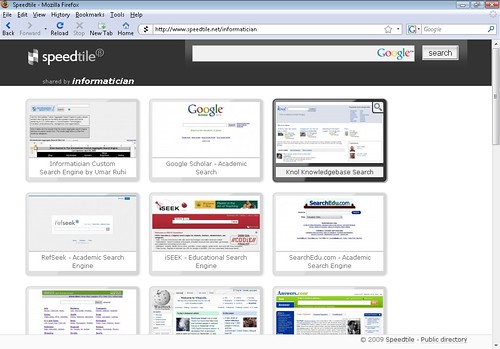 I often get asked by my students about my favorite search engines, my favorite help sites, my favorite e-commerce information pages etc. - so, I thought this might be an opportunity to share my bookmarks with not only my students – but the world at large.
I often get asked by my students about my favorite search engines, my favorite help sites, my favorite e-commerce information pages etc. - so, I thought this might be an opportunity to share my bookmarks with not only my students – but the world at large.In searching for a good bookmarking service, I came across Speedtile.net – a visual bookmarking service which is just freaking awesome! and with its firefox plugin, all I need to do is right click the web page I want to bookmark, and its done (as long as I’m logged into my speedtile account). For those who haven’t used Speedtile before, I really encourage you to give it a try. You can organize your bookmarks in different categories (structured as tabs on the website) and decide which specific ones you’d like to share by simply dragging and dropping the snapshots into the shared tab.In your profile, you can also select a label which will be used to personalize the URL for your shared bookmarks. In my case, I created two accounts – one to share my search engine and help sites bookmarks, and the other to share my ecommerce bookmarks.
The respective URLs are as follows:

The other good thing about speedtile is their fast and easy sign-up/registration process. I can’t remember the last time I gave out information only relevant to the service I’m signing up for. The registration form only asks for an email address and a password ! yeap… that’s it – check it out for yourself.
So check out speedtile, and check out my shared bookmarks at the URLs above. Let me know if I missed anything big from these bookmarks. I suspect I’ll be updating these on a regular basis.

 Like many other people I know, I’ve been waiting anxiously for
Like many other people I know, I’ve been waiting anxiously for 





 click to enlarge
click to enlarge